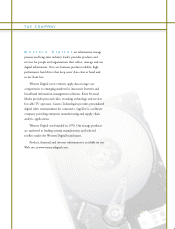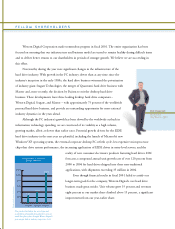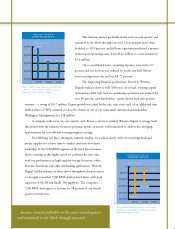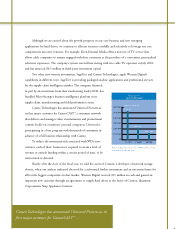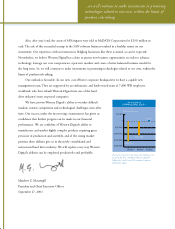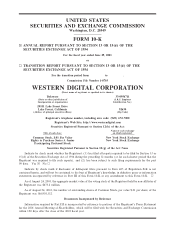Western Digital 2001 Annual Report Download - page 14
Download and view the complete annual report
Please find page 14 of the 2001 Western Digital annual report below. You can navigate through the pages in the report by either clicking on the pages listed below, or by using the keyword search tool below to find specific information within the annual report.Industry
Desktop PC Market. According to International Data Corporation (""IDC''), the desktop computer
segment is the largest segment of the worldwide personal computer market, accounting for approximately 79%
of global personal computer shipments in calendar 2000. As a result, desktop computers were the leading
source of demand for hard drives, accounting for more than 74% of all hard drive units shipped worldwide in
calendar 2000, according to IDC. Over 90% of Western Digital's hard drive unit shipments in 2001 were sold
to this market. Desktop personal computers for entry level to experienced users are used in both commercial
and consumer environments. The demand for hard drive capacity continues to grow in part due to:
‚ continued improvements in desktop computing price to performance ratios;
‚ continued growth of the sub-$1,000 PC market;
‚ the rapid accumulation of data resulting from the digitization of information previously stored in paper
form;
‚ larger Ñle sizes created by multimedia-intensive applications such as high-Ñdelity audio and video; and
‚ the exchange of increasing volumes of digital content among users across the Internet and intranets
with the proliferation of collaborative computing and sharing of audio and video content.
Future demand growth for desktop computer hard drives also may be driven by new and emerging hard
drive markets. In September 2001, IDC forecasted that the worldwide desktop PC hard drive market would
grow from approximately 139 million units in calendar 2001 to 193 million units in calendar 2005, reÖecting a
compound annual growth rate of approximately 8.5%. Revenue growth is expected to be lower due to the
impact of severe price competition. However, in August 2001, IDC forecasted that the non-desktop PC hard
drive market would grow from approximately 1.1 million units in calendar 2000 to 37.2 million units in
calendar 2004, reÖecting a compound annual growth rate of approximately 120%. See Part II, Item 7, under
the heading ""Risk factors related to the hard drive industry in which we operate.''
Desktop PCs are used in a number of environments, ranging from homes to businesses and multi-user
networks. Software applications are used on desktop PCs primarily for word processing, spreadsheet, desktop
publishing, database management, multimedia, entertainment and other related applications. Desktop PCs
typically utilize the EIDE interface for hard drives. The Company believes the minimum storage requirement
in the past year for entry-level PCs was generally 10 GB to 20 GB of formatted capacity.
The industry continues to supply increased capacity per unit as users' system needs increase and
technological and manufacturing advances continue to make higher capacity drives more aÅordable. In the
mainstream desktop PC market, the Company believes that the rate of increase in storage capacity per unit
has recently outpaced the rate of increase in demand for such capacity. This will result in the Company
changing its product mix, with an increasing percentage of lower capacity hard drives manufactured with
fewer heads and disks per unit. The Company believes that even though unit demand will increase, this
changing product mix will reduce the average selling price per hard drive unit in the desktop PC market. In
contrast, the emerging use of hard drives to record and play back audio and video content in the audio-visual
market is expected to create demand for storage capacity that will exceed the growth in demand for increased
capacity in the desktop PC market. Overall, industry sources believe that the current rate of increase in storage
capacity per unit shipped will continue for the foreseeable future. Accordingly, the Company believes that
time-to-market, time-to-volume and time-to-quality leadership with higher capacity drives at attractive price
levels will continue to be critical to its future success in serving this market.
Users of desktop PCs, especially entry-level desktop PCs, have become increasingly price sensitive. In
1999 the market for desktop PC's priced below $1,000 grew signiÑcantly, and in 2000 the market for desktop
PC's priced below $800 was the fastest growing segment of the market. Data for 2001 indicates that during the
latter part of 2001, the growth in sales of entry-level PCs had abated. These systems typically do not contain
high performance hard drives, but the growth of these segments in 1999 and 2000 has placed downward price
pressure on higher cost systems as well, thereby contributing to the increasing price pressures on desktop hard
4


